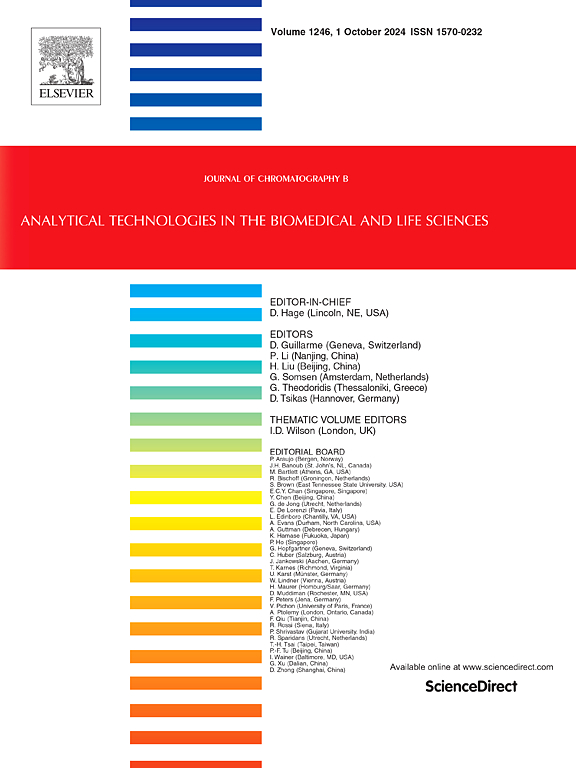pH-gradient cation exchange purification of IgG2 disulfide isoforms
IF 2.8
3区 医学
Q2 BIOCHEMICAL RESEARCH METHODS
引用次数: 0
Abstract
Immunoglobulin (IgG) based therapies are used to treat a wide range of diseases. The IgG2 subclass can have variable disulfide bond connectivity in the hinge region, leading to different isoforms. Interchain disulfide bonding isoforms that constrain the Fab arm structure may impact potency. Therefore, it is important to understand the abundance of IgG2 isoforms and the impact of function for IgG2s under development. In this work, a pH-gradient cation exchange separation was developed to purify IgG2 disulfide isoforms in their native state. The IgG2 mAb used for this study was not amenable to previously reported purification methods using salt-gradient cation exchange. Collected fractions were analyzed by high-resolution denaturing reversed phase chromatography and isoform content was determined with fluorescence detection. Fractions were then combined to generate solutions with varying amounts of IgG2-B isoform, ranging from 20.3 % to 80.8 % IgG2-B isoform. Across the range of IgG2-B isoform content abundances, all samples had similar levels of product related impurities and were amenable to potency testing. The work herein demonstrates a novel approach to natively fractionate disulfide isoforms for an IgG2 mAb that was not amenable to previous reported methods.
IgG2二硫异构体的ph梯度阳离子交换纯化
以免疫球蛋白(IgG)为基础的治疗方法用于治疗多种疾病。IgG2亚类在铰链区域具有可变的二硫键连通性,导致不同的同工异构体。约束Fab臂结构的链间二硫键异构体可能会影响效力。因此,了解IgG2亚型的丰度及其对正在开发中的IgG2s功能的影响是很重要的。在这项工作中,开发了一种ph梯度阳离子交换分离来纯化天然状态下的IgG2二硫化异构体。本研究中使用的IgG2单抗不适合先前报道的盐梯度阳离子交换纯化方法。采用高分辨率变性反相色谱法对所收集的馏分进行分析,采用荧光检测法测定异构体含量。然后将各组分组合成含有不同量IgG2-B异构体的溶液,IgG2-B异构体的含量从20.3%到80.8%不等。在IgG2-B异构体含量丰度范围内,所有样品都具有相似的产品相关杂质水平,并可进行效价检测。本文的工作展示了一种新的方法来分离IgG2单抗的原生二硫异构体,这是以前报道的方法所不能适应的。
本文章由计算机程序翻译,如有差异,请以英文原文为准。
求助全文
约1分钟内获得全文
求助全文
来源期刊

Journal of Chromatography B
医学-分析化学
CiteScore
5.60
自引率
3.30%
发文量
306
审稿时长
44 days
期刊介绍:
The Journal of Chromatography B publishes papers on developments in separation science relevant to biology and biomedical research including both fundamental advances and applications. Analytical techniques which may be considered include the various facets of chromatography, electrophoresis and related methods, affinity and immunoaffinity-based methodologies, hyphenated and other multi-dimensional techniques, and microanalytical approaches. The journal also considers articles reporting developments in sample preparation, detection techniques including mass spectrometry, and data handling and analysis.
Developments related to preparative separations for the isolation and purification of components of biological systems may be published, including chromatographic and electrophoretic methods, affinity separations, field flow fractionation and other preparative approaches.
Applications to the analysis of biological systems and samples will be considered when the analytical science contains a significant element of novelty, e.g. a new approach to the separation of a compound, novel combination of analytical techniques, or significantly improved analytical performance.
 求助内容:
求助内容: 应助结果提醒方式:
应助结果提醒方式:


